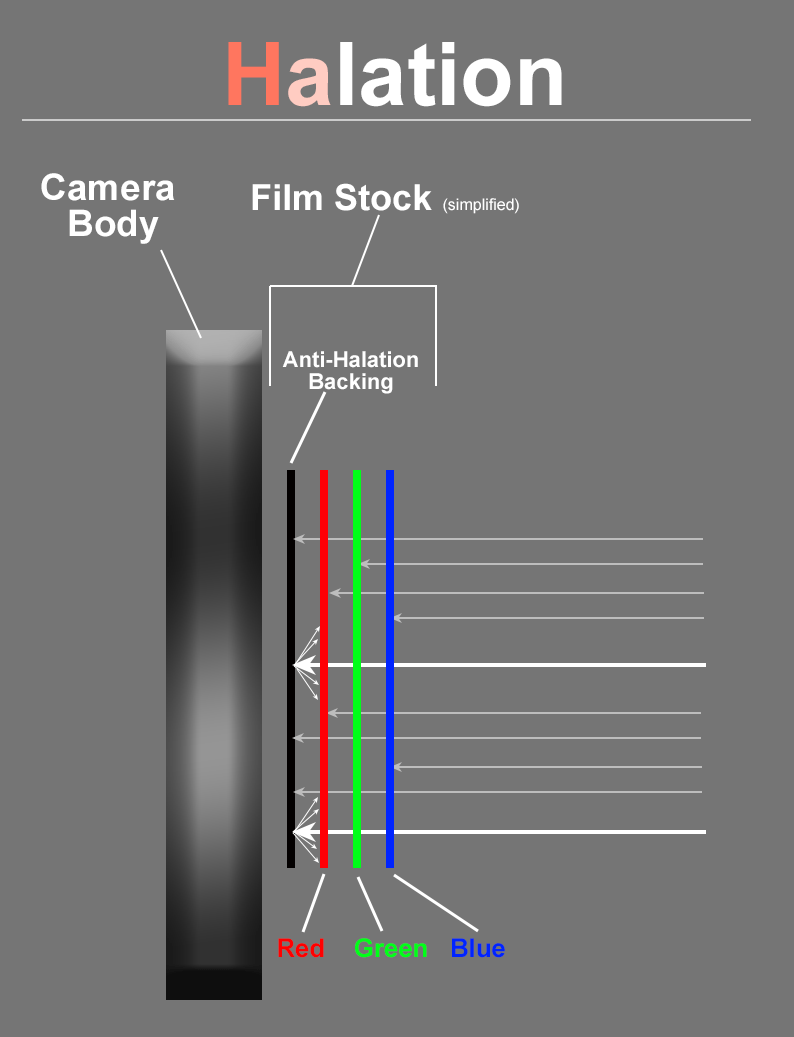antihalation on:
[Wikipedia]
[Google]
[Amazon]
 An anti-halation backing is a layer found in many
An anti-halation backing is a layer found in many
 An anti-halation backing is a layer found in many
An anti-halation backing is a layer found in many photographic film
Photographic film is a strip or sheet of transparent film base coated on one side with a gelatin photographic emulsion, emulsion containing microscopically small light-sensitive silver halide crystals. The sizes and other characteristics of th ...
s—and almost all film intended for motion picture cameras—usually a coating on the back of the film base
A film base is a transparent substrate which acts as a support medium for the photosensitive emulsion that lies atop it. Despite the numerous layers and coatings associated with the emulsion layer, the base generally accounts for the vast majority ...
, though it is sometimes incorporated between the light-sensitive emulsion
An emulsion is a mixture of two or more liquids that are normally immiscible (unmixable or unblendable) owing to liquid-liquid phase separation. Emulsions are part of a more general class of two-phase systems of matter called colloids. Althoug ...
and the base. Its purpose is to absorb light that passes through the emulsion, thus preventing any light from being reflected back through the emulsion from the rear surface of the base, or from anything behind the film, such as the pressure plate of the camera. This prevents a halo
Halo, halos or haloes usually refer to:
* Halo (optical phenomenon)
* Halo (religious iconography), a ring of light around the image of a head
HALO, halo, halos or haloes may also refer to:
Arts and entertainment Video games
* ''Halo'' (franch ...
-like effect (halation) from forming around bright points or edges in the image.
Still cameras, which handle less film and thus contend with less wear, typically hold their film in the gate with components painted or treated to be black, so reflections are less of an issue and few still films made use of anti-halation backings. The notable exception was Kodak's Kodachrome
Kodachrome is the brand name for a color reversal film introduced by Eastman Kodak in 1935. It was one of the first successful color materials and was used for both cinematography and still photography. For many years Kodachrome was widely used ...
, which incorporated such a backing to aid with a very sensitive innermost layer.
The anti-halation layer is rendered transparent or washed out during processing
Processing is a free graphical library and integrated development environment (IDE) built for the electronic arts, new media art, and visual design communities with the purpose of teaching non-programmers the fundamentals of computer programming ...
of the film, for example, the K-14 process
K-14 was the most recent version of the developing process for Kodak's Kodachrome transparency film before its discontinuation (the last revision having been designated Process K-14M). It superseded previous versions of the Kodachrome process used ...
for Kodachrome still film and the Eastman Color Negative Eastman Color Negative (ECN) is a photographic processing system created by Kodak in the 1950s for the development of monopack color negative motion picture film stock. It is part of the Eastmancolor family of products sold by Eastman Kodak.
The o ...
(ECN2) process for color motion picture film both have steps which remove this layer.
The lack of an anti-halation layer in Kodak High-Speed Infrared
Kodak High-Speed Infrared film, also known as Kodak HIE, was a popular black-and-white infrared photographic film from Kodak. The film was sensitive to the visible light spectrum (with decreased green sensitivity), infrared radiation up to 900nm i ...
(HIE) film caused the ethereal "glowing" effect often associated with infrared photography
''Top:'' tree photographed in the near infrared range. ''Bottom:'' same tree in the visible part of the spectrum.
In infrared photography, the film or image sensor used is sensitive to infrared light. The part of the spectrum used is r ...
, rather than an artifact of IR itself.
Motion pictures
This effect is particularly pronounced in motion picture cameras. These cameras are subject to the constant motion of film being dragged through the film gate, so most motion picture cameras have film movements made or plated with wear-resistant alloys such as hard chrome. Given such a relatively reflective pressure plate behind the film, many motion picture films use an anti-halation (and anti-static) backing. Different kinds of effects can be achieved by removing the anti-halation backing. Halation is one of the properties unique to analog film stock and isn't found in digital footage unless modified inpost-production
Post-production is part of the process of filmmaking, video production, audio production, and photography. Post-production includes all stages of production occurring after principal photography or recording individual program segments.
The ...
. Despite anti-halation backing, most film stock still renders a slight red halo around the brightest elements in a picture, where the incoming light is so strong that it cannot fully be absorbed by the anti-halation backing, and instead is scattered back into the red layer of the stock, creating additional, halo-like exposure in that particular layer, before it gets fully absorbed.
Halation can be digitally imitated to some degree, as shown below:
References
Photography equipment {{Photo-stub